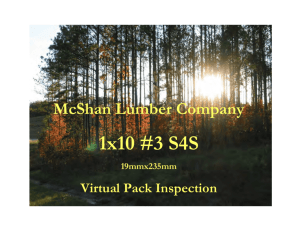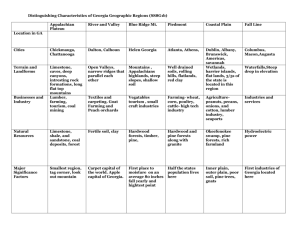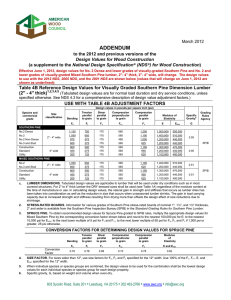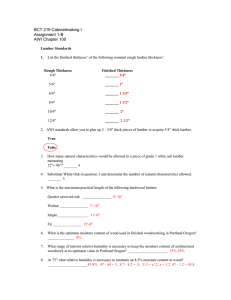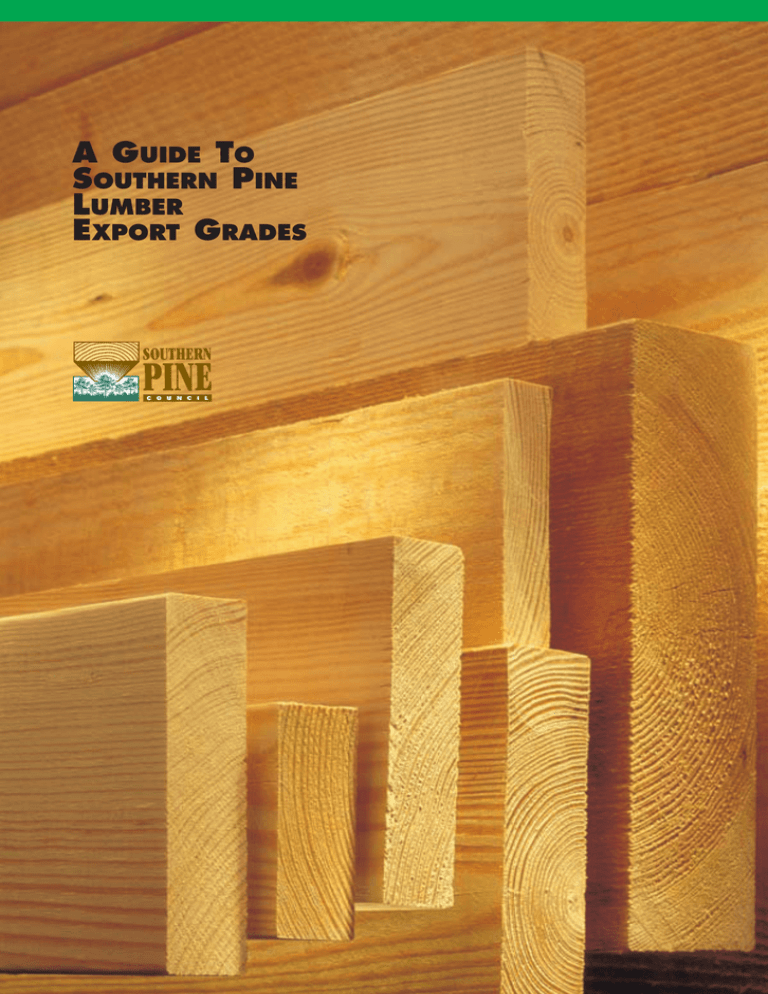
A GUIDE TO
SOUTHERN PINE
LUMBER
EXPORT GRADES
C ONTENTS
Lumber Grades, Grade Marks,
Dense Lumber
Construction Grades, Kiln Drying,
Timber Conservation
Select Structural
No. 1
No. 1 Construction Grade
No. 2
No. 2 & Better Construction Grade
No. 3
No. 3 & Better Construction Grade
Saps
Prime
Merchantable Timbers
Moulding Stock
No.1 Shop Grade
No. 2 Shop Grade
Radius Edge Decking
V-Groove Pattern
Double-Beaded Pattern
Flooring
Boards
Additional Information,
Reinspection Availability
USING THIS BOOKLET
1
2
3
4
5
6
7
8
9
10
11
12
13
14
15
16
17
18
19
20
21
The Southern Pine council does not
grade or test lumber. Information
contained herein is taken from the 2002
Standard Grading Rules for Southern
Pine Lumber, 2002 Edition, and the
Export Grading Rules, 1982 Edition,
both published by the Southern Pine
Inspection Bureau (SPIB).
The conditions under which lumber is
used in construction may vary widely,
as does the quality of workmanship.
Neither the Southern Pine Council nor
its members have knowledge of the
quality of the workmanship or construction methods used on any construction
project, and accordingly, do not warrant
the design or performance of the lumber in completed structures.
This publication includes
photographs of Southern Pine
lumber, illustrating a range of
typical lumber grades. The
samples shown are representative
lumber mill production practices.
The primary characteristic of
each grade are defined, along
with the typical applications.
This publication is not a lumber
grading manual. The information
presented here is intended as a
guide for buyers, users, and
specifiers to properly identify the
grade of Southern Pine that best
meets their requirements.
Lumber production practices
vary from mill to mill.
Manufacturers of rough, kilndried Southern Pine destined for
export markets have the
capability to produce lumber to
different specifications and
variances, depending on the
specific needs of a customer, or
the intended application.
SOUTHERN PINE LUMBER
Southern Pine grows in a wide
geographic belt, stretching from
East Texas through Virginia.
The name Southern Pine, or
Southern Pine Yellow Pine, is
representative of a group of four
principal tree species: longleaf,
shortleaf, loblolly, and slash.
Lumber from all four species is
marketed as Southern Pine and
graded in accordance with the
grading rules of Southern Pine
Inspection Bureau (SPIB),
approved by the American
Softwood Lumber Standards
Committee. The natural
characteristics that distinguish
Southern Pine as a most
versatile and durable building
material are:
High Strength – Design
values assigned for Southern
Pine are among the highest of
all softwoods. Southern Pine has
earned a reputation as the
“Supreme Structural Wood of
the World”.
Durability – Southern Pine is
highly resistant to wear. It is
ideally suited for high-traffic
applications such as boardwalks,
decks, and flooring.
Fastener Holding –
Southern Pine’s ability to hold
nails and other fasteners is
among the highest of all
softwoods. Drying (or seasoning)
of Southern Pine lumber
enhances fastener-holding
capability.
Treatability – Southern Pine
has long been a preferred species
when pressure treatment with
preservatives is required. The
unique cellular structure of
Southern Pine permits deep,
uniform penetration of
preservatives, rendering the
wood useless as a food source for
fungi, termites and microorganisms.
Most wood species do not
readily accept preservatives, and
must first be incised, or
perforated with a series of small
slits along the grain of the
wood’s surface. Incising allows
sufficient penetration of the
preservative to meet American
Wood Preservers’ Association
(AWPA) Standards. Southern
Pine is one of the few wood
species that does not require
incising prior to treatment.
Copyright © 2002 Southern Forest Products Association. All rights reserved.
LUMBER GRADES
DENSE LUMBER
Southern Pine lumber is
produced in different grades, as
well as different sizes. Each
lumber grade limits certain
characteristics such as knots,
checks and splits. Along with
manufacturing imperfections,
these characteristics will
contribute to the overall
appearance of a piece of lumber.
At the mill, lumber grades are
assigned by visual inspection of
each piece. For lumber destined
to be used in U.S. construction
markets, this inspection is more
a judgement of the relative
strength properties within a
piece than of its appearance. For
material to be exported,
appearance considerations as
well as relative strength properties
of a piece are often a deciding
factor in assigning a lumber grade.
The samples pictured in this
publication include examples of
allowable characteristics within
each grade, as described in SPIB’s
2002 Standard Grading Rules,
and SPIB’s Export Grading Rules,
1982 Edition, approved by the
American Standards Committee,
in accordance with Product
Standard PS 20-94.
A complete lumber grade
description should be included
with any buyer’s order, and is
considered an agreement between
buyer and seller of specific
characteristics allowed within
each grade purchased.
Wood density is another characteristic
that affects the strength of a piece of
lumber. Density is related to a tree’s
rate of growth; the more annual growth
rings per inch, the greater the density
of the lumber.
For purposes of lumber grading, and
as defined with the SPIB Standard
Grading Rules for Southern Pine Lumber, density is divided into two classifications:
Dense – six or more annual growth
rings per inch and at least one third
summerwood, or four rings per inch
and at least 50% summerwood.
NonDense – fewer rings and less
summerwood than in dense lumber.
SPECIFY GRADE-MARKED SOUTHERN PINE
Quality Southern Pine lumber is
graded in accordance with the
grading rules of the Southern Pine
Inspection Bureau (SPIB). SPIB,
Timber Products Inspection, Inc.
(TP), Renewable Resource
Associates, Inc. (RRA) and other
organizations are accredited by
American Lumber Standard
Committee, Inc. (ALSC) to inspect
and grade mark Southern Pine
1
4
7
lumber in accordance with SPIB
grading rules.
An authorized grade mark on
each piece of Southern Pine
lumber assures the buyer that the
product specified is being
received. The inspection agency is
identified (SPIB, TP or RRA
among others **) along with the
grade of the piece, its moisture
content, and a mill number
identifying the manufacturer.
SFPA members can include the
association’s logo in the grade
mark, but this logo is optional.
5
8
2
4
9
7
5
6
4
3
7
5
6
8
Pictured: 2x4 Dense Select Structural (top);
2x4 No. 1 NonDense (bottom)
Dense lumber, which is stronger than
nondense lumber, may be specified
when higher design values are
required.
For this publication, nondense grades
are pictured. Certain Southern Pine
mills produce dense grades, though
availability of all dense grades may be
limited. Grade designations for dense
lumber are:
Dense Select Structural
No. 1 Dense
No. 2 Dense
1. Inspection Service: Southern Pine
Inspection Bureau (SPIB)
2. Inspection Service: Timber Products
Inspection, Inc. (TP)
3. Inspection Service: Renewable Resource
Associates, Inc. (RRA)
4. Lumber Grade
5. Mill Identificaiton Number
6. Lumber Species
7. (optional) Logo denoting a member mill of
Southern Forest Products Association (SFPA)
8. Moisture Content: (MC) Kiln-dried (KD) to a
maximum of 19%*
9. Moisture Content: (MC) Kiln-dried (KD) to a
maximum of 15%*
*Information regarding Moisture Content (MC) can be denoted as
“KD” or “KD19”, kiln-dried to 19% moisture content; “KD15”, kilndried to 15% moisture content; “MC15”, air dried and/or kiln-dried to
a maximum moisture content of 15%.
**NOTE: Other agencies are accredited by ALSC to inspect and grade all or selected Southern Pine products according to SPIB
Grading Rules, including: California Lumber Inspection Service (CLIS); Northeastern Lumber Manufacturers Association (NELMA);
West Coast Lumber Inspection Bureau (WCLIB); and Western Wood Products Association (WWPA).
1
CONSTRUCTION GRADES
Lumber production practices vary
among mills. Many Southern Pine
mills produce and market material
destined for export markets classified
under a category known as
“Construction Grades”:
No. 1 Construction Grade
No. 2 & Better
No. 3 & Better
This material is all rough-sawn, kilndried lumber cut to full dimension
widths and thicknesses, and graded to
meet the requirements of the corresponding lumber grade as described
in the SPIB Standard Grading Rules
for Southern Pine Lumber, 1994 Edition. Construction Grades are made
available to importers, buyers and
specifiers outside the U.S. for custom
remanufacturing, or to be resawn to
specific sizes (e.g. metric) or patterns.
KILN DRYING ASSURES DIMENSIONAL STABILITY
The vast majority of Southern
Pine lumber production is
properly seasoned, by drying in a
kiln, to a maximum moisture
content of 19%. Kiln drying the
lumber not only improves
dimensional stability, its
strength and appearance, but
also minimizes shrinkage of the
final product in service. In
addition, kiln drying is an
accepted method of sterilizing
the lumber from the unwanted
transfer of micro-organisms.
Southern Pine grading rules
restrict moisture content of
lumber 50mm (2") or less in
thickness to a maximum of
19%. If specified as “KD19”, the
maximum is 19 percent .
Moisture content restrictions
apply at the time of shipment to
the buyers, as well as at the time
of dressing if dressed lumber is
involved.
Material identified by a
certified grade mark is evidence
that the Southern Pine lumber
has been properly seasoned, and
is considered sterilized by most
importing countries.
Lumber absorbs or loses
moisture depending on the
surrounding temperature and
humidity. Within a typical
shipment, Southern Pine lumber
dried to a maximum moisture
content of 19% will average
15% and if dried to a maximum
moisture content of 15% will
average 12%.
Once kiln-dried Southern
Pine shipments are delivered,
proper storage is essential to
maintain dimensional stability.
For builders and other users,
kiln-dried lumber reduces costly
and unsightly problems such as
warp, twist, stain, and crook.
AN ENVIRONMENTAL ASSET
Wood products have so many cost
and construction advantages over
other building materials that it is easy
to forget what an environmental asset
it is to use wood.
We sometimes forget that wood is
naturally reusable, recyclable and
biodegradable. Or the best insulator
of all structural building materials,
thus conserving finite fossil fuel and
coal by requiring less energy to heat
an cool a home built with wood. Or
that it takes far less energy to
transform trees into wood products
than it does to manufacture steel,
aluminum, masonry or plastic
products. Less pollution of the air
2
and water, too.
Wood is also renewable. Ores and
petroleum used for nonwood
products, once use are not
renewable. They are gone forever.
Trees however, are forever.
Contrary to what alarmists say.
America is not running out of trees.
More trees are grown each year in the
U.S. than are harvested or lost to
disease. insects and fire. A third of
America is covered with trees today,
more than we had 75 years ago. And
being planted at the rate of nearly
four million a day -- five trees a year
for every American.
Finally, remember that a growing
forest removes the greenhouse gas
carbon dioxide, while giving off lifesustaining oxygen. Can you think of a
better environmental exchange than
that?
SELECT STRUCTURAL
This is a high-quality grade, relatively
free of characteristics which impair
strength or stiffness. Recommended
for uses where high strength, stiffness,
and good appearance are desired.
Typical applications may include
ceiling and floor joists, and exposed
roof rafters.
Pictured: 2x4 (38mm x 89mm) Select Structural
Length: 12' (3.94m)
3
NO. 1
This grade is recommended for general
utility and construction where high
strength, stiffness, and good appearance
are desired. Typical uses may include the
bottom chord of an engineered truss, the
part where is highest strength is required,
or for long-span floor joists.
Pictured: 2x6 (38mm x 140mm) No. 1
Length: 10' (3.048m)
4
NO. 1
CONSTRUCTION GRADE
Rough sawn, kiln dried, and
manufactured to full dimension
sizes in thickness and width.*
Pictured: 2x6 (50mm x 100mm) No.1 Construction Grade
Length: 10' (3.048m)
*See the product
description
“Construction
Grades” on page 2.
5
NO. 2
This grade is the most commonly
available and is recommended for
most general uses where moderately
high design values are required.
Pictured: 2x6 (38mm x 140mm) No. 2
Length:10' (3.048m)
6
NO. 2 & BETTER
CONSTRUCTION GRADE
Rough sawn, kiln dried, and
manufactured to full dimension
sizes in thickness and width.*
Pictured: 2x6 (50mm x 150mm) No. 2 Construction Grade
Length: 10' (3.048m)
*See the product
description
“Construction
Grades” on page 2.
7
NO. 3
This grade is assigned design values to meet a wide range of design
requirements. It is recommended for general construction applications
where appearance is not a controlling factor. Many pieces within this
grade would qualify as No. 2 except for a single limiting characteristic.
This lumber grade is commonly used for truss webs, or for non-building
applications such as pallets, concrete forming, and other industrial uses.
Pictured: 2x6 (38mm x 140mm) No. 3
Length: 10' (3.048m)
8
NO. 3 & BETTER
CONSTRUCTION GRADE
Rough sawn, kiln dried, and
manufactured to full dimension
sizes in thickness and width.*
Pictured: 2x6 (50mm x 150mm) No. 3 Construction Grade
Length: 10' (3.048m)
*See the product
description
“Construction
Grades” on page 2.
9
SAPS
Rough sawn, and kiln dried to
a maximum moisture content
of 19%, this material measures
7/8" x 3" and wider through
3" x 3" and wider. Saps are
Pictured: 1"x4" (25mm x 100mm) Saps
Length: 10' (3.048m)
10
primarily used in resaw and
remanufacturing operations to
produce items for joinery,
moulding, millwork, furniture,
paneling, and drop siding.
NOTE: Prior to shipment, the buyer
and seller will determine what
constitutes a complete grade
description of this material.
PRIME
Rough sawn and kiln dried to a
maximum moisture content of
19%, this material measures
11⁄2" x 4" and wider through
4" x 4" and wider. Prime
material can be remanufactured
Pictured: 3"x8" (75mm x 200mm) Prime
Length: 10' (3.048m)
into thicker sizes, similar to
dimension. It may be suitable
for structural uses, such as
exposed rafters. It is also ideal
for furniture, flooring, and
joinery applications.
NOTE: Prior to shipment, the buyer
and seller will determine what
constitutes a complete grade
description of this material.
11
MERCHANTABLE
TIMBERS
This material is suitable for
remanufacturing operations requiring
finished material of large sizes.
These timbers must be dense
grain, and permit certain
characteristics, including:
According to the SPIB Export
Grading Rules, this rough-sawn
material measures 6" x 6" and larger.
• No splits, holes, or unsound
wood
• Large surfaces checks
Pictured: 3"x8" (75mm x 200mm) Prime
Length: 10' (3.048m)
12
NOTE: Available sizes of Southern Pine timbers marketed as
“merchantable” vary widely, often smaller than the 6" x 6"
size specified in the SPIB Export Grading Rules. This
descrepancy is usally the result of standard and accepted
lumber production practices intended to achieve maximum
recovery from the timber resource.
MOULDING STOCK
This high-quality grade
is recommended for
remanufacturing into
specialty products,
including mouldings,
millwork items and
furniture. Moulding
stock is material suitable
for ripping into strips 1"
(25mm) and wider, 10'
(3,048m) and longer. It
is graded from the
poorest face. Typically,
this grade is produced in
random widths ranging
from 6" (150mm)
through 12" (300mm);
thicknesses range from
4/4 (1" or 25mm)
through 8/4 (2" or
50mm). Typically, this
material is surfaced two
sides (S2S), and kiln
dried to a maximum
moisture content of
12%.
NOTE: Cutting lines shown
on these samples are
representational. These
lines serve only as a visual
guide to supplement the
explanation of how this
grade of material may be
used. Typically, rips are
made before crosscuts.
Pictured:
2x6 (38mm x140mm)
2x8 (38mm x 190mm)
2x10 (38mm x 250mm)
2x12 (38mm x 300mm)
Moulding Shop Grade
Length: 16' (4.88m)
13
NO. 1
SHOP GRADE
This high-quality grade
is recommended for
remanufacturing into
specialty products,
including mouldings,
window and door
components, as well as
furniture. This grade is
produced in random
widths ranging from 6"
(150mm) through 12"
(300mm); thicknesses
range from 4/4 (1" or
25mm) through 8/4 (2"
or 50mm). It is graded
from the poorest face.
Typically, this material
is surfaced two sides
(S2S), and kiln dried to
a maximum moisture
content of 12%.
NOTE: Cutting lines shown
on these samples are
representational. These
lines serve only as a visual
guide to supplement the
explanation of how this
grade of material may be
used. Typically, rips are
made before crosscuts.
Pictured:
2x6 (38mm x140mm)
2x8 (38mm x 190mm)
2x10 (38mm x 250mm)
2x12 (38mm x 300mm)
No.1 Shop Grade
Length: 16' (4.88m)
14
NO. 2
SHOP GRADE
This grade is
recommended for
remanufacturing into
specialty products,
including millwork
items, furniture, plus
window and door
components. This grade
is produced in random
widths ranging from 6"
(150mm) through 12"
(300mm); thicknesses
range from 4/4 (1" or
25mm) through 8/4 (2"
or 50mm). It is graded
from the poorest face.
Typically, this material
is surfaced two sides
(S2S), and kiln dried to
a maximum moisture
content of 12%.
NOTE: Cutting lines shown
on these samples are
representational. These
lines serve only as a visual
guide to supplement the
explanation of how this
grade of material may be
used. Typically, rips are
made before crosscuts.
Pictured:
2x6 (38mm x140mm)
2x8 (38mm x 190mm)
2x10 (38mm x 250mm)
2x12 (38mm x 300mm)
No.2 Shop Grade
Length: 16' (4.88m)
15
RADIUS EDGE
DECKING –
R.E.D.
This material is available in two
grades. PREMIUM and STANDARD;
PREMIUM grade offers higher
appearance characteristics. This
material features a rounded surface
on all four edges; the rounding is on
a radius of 1/4" or 6.35mm. In all
widths, the dressed thickness is 1" or
PREMIUM GRADE
Pictured: 5/4x6" (25mm x 140mm) Radius Edge Decking - R.E.D.
Length: 10' (3.048m) Pressure treated with a waterborne preservative.
Premium Grade (left); Standard Grade (right)
TYPICAL R.E.D. CERTIFIED GRADE MARKS
25mm. Typically, this product is
pressure treated with a
waterborne preservative for
outdoor deck surfaces, as well as
for planters, benches and steps.
The product designation
“R.E.D.” is included within the
certified lumber grade mark.
STANDARD GRADE
NOTE: This product is graded
according to SPIB’s Special Product
Rules for Radius Edge Decking,
1986 Edition.
END PROFILE
1", 25mm
5 1⁄2", 140mm
16
V-GROOVE PATTERN
DROP SIDING, PANELING
This high-quality material
is recommended for exterior drop
siding or interior paneling
applications. Adjacent pieces of
this pattern form a distinctive
"V" joint. Typically produced
in a nominal width of 6˝
(150mm), available lengths
range from 8´ (2.44m) to
16´ (4.88m). Dressed
thickness will vary by
manufacturer; 3/4˝
(19mm) and 5/8˝ (16mm) are
the most common.
This product is generally noted
for its high-quality appearance. A
grade of C&Btr is most
commonly specified. This is a
clear grade, but a limited number
of surface checks and small tight
knots are permitted. This grade is
excellent for painting or a natural
finish.
Pictured:
1x6 (19mm x 150mm) V-Groove,
C&Btr Grade
1 "
⁄4
1 "
⁄4
(6.35mm)
3/4"
(19mm)
5 1⁄8" (130mm)
D GRADE
This is a good-quality grade
containing some small knots and
checks. It is suitable for a painted
or natural finish.
NO.2 GRADE
This grade contains
more numerous and
larger tight
knots. It is
suitable for
less demanding,
general-purpose uses.
17
DOUBLE -BEADED PATTERN
DB CEILING
This high-quality material
is recommended for interior
paneling applications, typically for
ceilings and wainscoting. Surfaces
using this pattern are highlighted
by the distinctive raised double
bead. Typically produced in a
nominal width of 4˝ (100mm),
available lengths range from 8´
(2.44m) to 16´ (4.88m). Dressed
thickness will vary by
manufacturer; 3/4˝ (19mm) and
5/8˝ (16mm) are the most
common.
A grade of C&Btr is noted
for its high-quality appearance,
and is most commonly specified.
This is a clear grade, but a limited
number of surface checks and
small tight knots are permitted.
This grade is excellent for
painting or a natural finish.
D GRADE
This is a good-quality grade
containing some small knots and
checks. It is suitable for a painted
or natural finish.
NO.2 GRADE
This grade contains more
numerous and larger tight knots.
It is suitable for less demanding,
general-purpose uses.
18
31⁄8" (78mm)
Pictured: 1x4 (19mm x 100mm)
DB Ceiling,
C&Btr Grade
3/4"
(19mm)
FLOORING
This high-quality material is
recommended for interior flooring
applications. Nominal standard
widths range from 2˝ (50mm) to
6˝ (150mm). Wider widths are
also manufactured. Available
lengths range from 8´ (2.44m) to
16´ (4.88m). Dressed thickness
will vary by manufacturer; 3/4˝
(19mm) and 1˝ (25mm) are the
most common. Material specified
as 1˝ has an actual thickness of
3/4˝; material specified as 5/4 has
an actual thickness of 1˝. If not
otherwise specified, this material
will have tongue-and-groove
(T&G) edges and plain ends.
During manufacture, the
position of the log relative to the
saw cut determines the wood
grain's orientation. Flat grain
Southern Pine flooring is more
widely available. Vertical or edge
grain flooring features a harder
wearing surface than flat grain
material, and may be desirable in
high-traffic applications.
Pictured:
(Above)
1x4 (19mm x 100mm)
C&Btr T&G Flooring,
Vertical Grain
(Left)
1x4 (19mm x 100mm)
C&Btr T&G Flooring,
Flat Grain
FLAT GRAIN
VERTICAL GRAIN
3/4"
(19mm)
3 1⁄8" (78mm)
C&BTR GRADE
This grade is the most commonly
specified for optimum appearance
and satisfies requirements for a
high-quality finish. Flooring grades
are based upon appearance
criteria, limiting defects such as
tight knots, splits, or wane.
1x4 (19mm x 100mm)
C&Btr T&G Flooring,
Flat Grain
1x4 (19mm x 100mm)
C&Btr T&G Flooring,
Vertical Grain
NO. 2 GRADE
This grade requires a face as good
as No.2 Boards. This grade of
flooring features high utility value
where appearance is less important.
Pictured:
1x6 (19mm x 150mm)
T&G No.2 Flooring
NOTE: Detailed information about
Southern Pine flooring – product
selection, installation and maintenance –
is provided in the booklet “A Guide to
Southern Pine Flooring” available from
the Southern Pine Council. To obtain a
copy, refer to page 21.
19
BOARDS
According to SPIB Grading
Rules, Boards are classified as
material measuring 1˝ to 1-1/2˝
thick, 2˝ and wider. This S4S
material is available in a wide
range of sizes and grades,
meeting most any requirement
for utility, economy, and
appearance. Uses include
shelving, packaging and form
lumber. Boards may also be
remanufactured into a variety
of patterns.
Dressed thickness will vary by
manufacturer; 3/4˝ (19mm)
and 1˝ (25mm) are the most
common. Material specified as
1˝ has an actual thickness of
3/4˝; material specified as 5/4
has an actual thickness of 1˝.
Nominal standard widths range
from 2˝ (50mm) to 12˝
(305mm). Available lengths
range from 8´ (2.44m) to 16´
(4.88m).
20
NO.1 GRADE
This material features superior
appearance characteristics:
generally few sound, tight knots
and suitable for a high-quality finish.
Pictured: No.1 1x6 (19mm x 150mm) Boards
NO.2 GRADE
This good-quality material is
suitable for general purpose uses
including sheathing, fencing,
packaging, and shelving.
Pictured:
No.2 1x6 (19mm x 150mm) Boards
ADDITIONAL INFORMATION
Publications from the Southern
Pine Council offer helpful
information for importers,
designers, specifiers, and users of
wood products. Consult the
following booklets:
➤ Southern Pine Lumber: An
Importer’s Reference Guide
Forest resources, manufacturing, product
descriptions (16 pages)
➤ International Buyer’s Guide
Listings of SPC member mills, products
manufactured and sales managers
(24 pages)
Editions: English, Spanish, Japanese
A single copy of each booklet is
free upon request; please specify
desired language. Direct all
inquiries to:
Editions: English, Spanish, Japanese, French,
German, Italian, Korean
➤ Pressure-Treated Southern Pine
Preservative retentions, standards, proper
use and handling (16 pages)
Editions: English, Spanish, Japanese
Southern Pine Council
P.O. Box 641700
Kenner, LA 70064 USA
www.southernpine.com
➤ A Guide to Southern Pine Flooring
Product selection, proper installation,
finishing and maintenance (20 pages)
The Southern Pine Council (SPC) is a
nonprofit organization supported by
the producing members of the
Southern Forest Products Association
and the Southeastern Lumber
Manufacturers Association.
One objective of SPC’s International
Program is dedicated to increasing the
volumes of Southern Pine products
available to world markets.
Activities within the program include
market development, trade advertising,
plus distribution of multi-lingual
promotional and technical publications.
Southern Forest
Products Association
Editions: English, Spanish, Japanese
P.O. Box 641700
Kenner, LA 70064 USA
Tel: 504/443-4464
FAX: 504/443-6612
Southeastern Lumber
Manufacturers Association
REINSPECTION AVAILABILITY
In the absence of a special
agreement between buyer and
seller, the SPIB Standard Grading
Rules for Southern Pine Lumber
provide that the purchase, sale or
shipment of lumber designated by
grades described in the SPIB
grading rules must be construed as
involving an agreement to abide by
all applicable provisions of the
rules, including submission to
inspection of any lumber complaint
as to size, grade, or tally. For
complete reinspection information,
contact:
P.O. Box 1788
Forest Park, GA 30298 USA
Tel: 404/361-1445
FAX: 404/361-5963
www.southernpine.com
SPC AROUND
THE
GLOBE
The Southern Pine Council maintains
offices outside the United States to
assist lumber buyers and specifiers.
In the United Kingdom:
Eddie Pearce
Southern Pine Council
Southern Pine is a preferred lumber species for
structural framing and engineered components.
25 Castle St., High Wycombe
Bucks, HP13 6RU ENGLAND
Tel: 44-1494-451000
FAX: 44-1494-451100
e-mail: americansoftwoods@compuserve.com
In Spain:
Southern Pine Inspection Bureau
Ignacio Martinez
Southern Pine Council
4709 Scenic Highway
Pensacola, FL 32504-9094 USA
Tel: 850/434-2611
FAX: 850/443-5594
www.spib.org
e-mail: spib@spib.org
Calle Venus 36
28224 Pozuelo de Alarcón
Madrid, SPAIN
Tel/FAX: (34-91) 351-1449
e-mail: americansoftwoods@jpcnet.com
Timber Products Inspection, Inc.
In Mexico:
P.O. Box 919
Conyers, GA 30207 USA
Tel: 770/922-8000
FAX: 770/922-1290
www.tpinspection.com
e-mail: tpinsp@mindspring.com
Dr. Ramon Echenique-Manrique
Southern Pine Council
Apartado Postal 459
Xalapa, Veracruz, 91000 MEXICO
Tel: (52) 228-816-4780
Tel/FAX: (52) 228-816-3850
e-mail: mecma_sa@terra.com.mx
Renewable Resource Associates, Inc.
3091 Chaparral Place
Lithonia, GA 30038
Tel: 770/482-9385
FAX: 770/484-2541
e-mail: rra.inc@mindspring.com
In Japan:
Daisaku Aoki
Southern Pine Council
Southern Pine can be remanufacturered into a wide
variety of patterns for millwork and joinery.
Tamaike Tokyu Bldg. 8F
1-1-14 Akasaka
Minatoku, Tokyo 107 JAPAN
Tel: (31) 33589-1320
FAX: (31) 33589-1320
(31) 33505-6710
e-mail: daisaku-aoki@gol.com
SFPA #570 5M/9-02
21
SOUTHERN FOREST PRODUCTS ASSOCIATION
P.O. BOX 641700 KENNER, LA 70064-1700
504/443-4464 • FAX 504/443-6612
SOUTHEASTERN LUMBER MANUFACTURERS ASSOCIATION
P.O. BOX 1788 FOREST PARK, GA 30298
404/361-1445 • FAX 404/361-5963
www.southernpine.com

